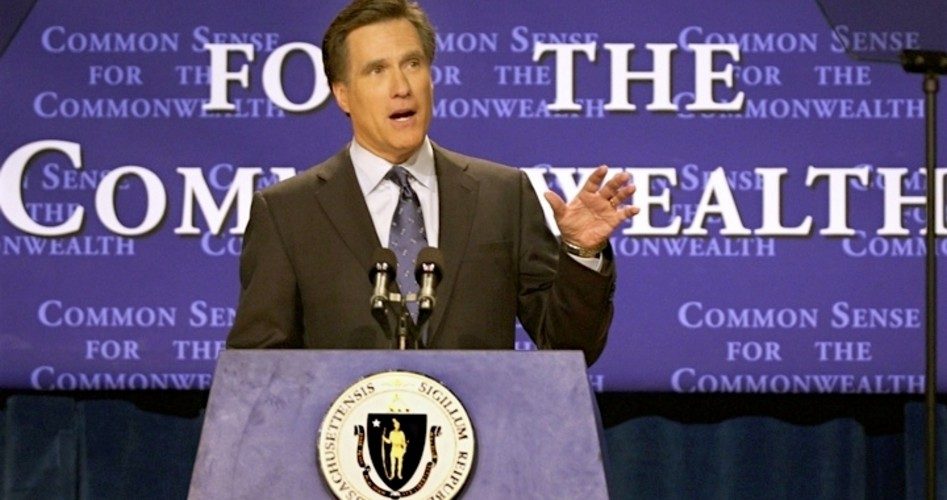
As surely as night follows day, one government intervention begets another. In Massachusetts, the 2006 healthcare reform law signed by then-Gov. Mitt Romney forced every Bay Stater to buy health insurance and every insurer to cover every applicant regardless of preexisting conditions. Not surprisingly, this created an increase in demand for medical care, driving prices and insurance premiums to the highest levels in the nation.
Now, rather than admit their mistake and repeal Romneycare, elected officials are compounding their errors by imposing cost controls on healthcare. A bill doing just that passed the state House of Representatives overwhelmingly (132-20) and the Senate unanimously. Gov. Deval Patrick signed it into law Monday, saying, “This is a commonwealth that has shown the nation how to extend coverage to everyone, and we’re going to crack the code now on cost control.”
The state’s chosen means of decryption is simply to demand that costs be kept below an arbitrary target. Specifically, for each year through 2017 healthcare spending may not increase faster than Massachusetts’ Gross State Product (GSP) — about half the rate at which it is currently rising. Then from 2018 to 2022 its growth is capped at half a percentage point below the rate of GSP increase. Also, instead of paying providers for each service provided, insurers will be strongly encouraged to pay them on a per-patient basis.
And that’s just the beginning. “Joshua Archambault of the Pioneer Institute finds 941 instances in which the [House version of the] bill mandates that something ‘shall’ be done,” writes Boston Globe columnist Jeff Jacoby. “Among these are more than 25 kinds of penalties, fines, and surcharges, for price control and punishment always go hand in hand.” For instance, a healthcare provider that fails to meet the state’s cost-control targets and does not file or implement a plan to meet them could be fined $500,000.
In addition to setting cost targets, the law mandates electronic health records for all patients, increases state Medicaid payment rates (which will surely prove unhelpful in cutting costs), and imposes a tax on hospitals that charge more than 120 percent of the state median price for a given service.
In charge of implementing all 237 pages of the law is a new Commonwealth Health Care Quality and Finance Authority, whose purpose, according to the legislation, is “to set health care cost containment goals for the commonwealth and to foster innovative health care delivery and payment models that lower health care cost growth while improving the quality of patient care.” What’s more, the authority “shall be an independent public entity not subject to the supervision and control of any other executive office, department, commission, board, bureau, agency or political subdivision of the commonwealth except as specifically provided in any general or special law.” In other words, the authority will essentially have untrammeled power to dictate healthcare costs. And despite the nod to the quality of care, as in all government operations, meeting budgetary targets will take precedence over serving individuals. Price controls, after all, can only lead to shortages and concomitant corner-cutting and rationing.
Of course, that assumes that the law actually succeeds in controlling costs, an outcome Forbes’ Avik Roy finds improbable. The “luxury tax” on costly services can, he says, be circumvented fairly easily. First, high-cost providers can exploit “vague definitions” in the law that give the Health Care Quality and Finance Authority plenty of leeway in exempting politically favored providers from the tax. Second, “it will be very easy for high-priced hospitals with significant market power to charge more for other services” to recoup the cost of the surcharge, notwithstanding the law’s express prohibition of passing the cost along to consumers. Third, expensive providers can simply wait for lower-cost competitors to raise their prices, as they almost certainly will do since the law’s transparency provisions will force all providers to make their fees public.
For example, let’s say Mass General charges $32,000 for a coronary angioplasty, whereas the state median is $21,000, driven in part by low-cost Tufts, which is charging $16,000. Now that Tufts knows that MGH is charging $32,000, Tufts knows that it can charge, say, $25,000 per procedure, and still gain favorable status from insurers, without incurring the new “luxury tax.”
Once Tufts raises its price to $25,000, the “median” price for angioplasties in the state goes up, allowing MGH to raise its price further, and the cycle repeats itself.
Moreover, he points out, “global budgeting doesn’t work” because “individual doctors are always capable of outsmarting the bureaucrats,” whether to serve patients better or to protect themselves from lawsuits. Various Medicare cost-control projects since the 1970s have failed; Roy believes Massachusetts’ attempt will likewise flop.
Then again, perhaps the real purpose of the legislation isn’t to curtail costs but to protect the interests of the big healthcare players. “House Speaker Robert A. DeLeo, Representative Steven M. Walsh, co-chairman of the Committee on Health Care Financing, and Attorney General Martha Coakley … all praised the work that industry executives and advocates did in writing the bill,” the Boston Globe reports. Industry executives returned the favor, heaping accolades on the law they helped author.
Whatever the purpose of the law, one thing is for certain, remarked Joshua Archambault: “The character who should be the hero of this drama, the patient, is nowhere to be found.”
Instead, avers Jacoby, “decision after decision comes not through the voluntary interplay of doctors, patients, hospitals, and insurers, but from government agents who impose them from above.” Furthermore, he explains:
Bureaucrats, no matter how well intentioned, cannot know how much medical services should cost or how insurance premiums should grow. Ham-fisted state intervention is responsible for much of what ails the Bay State’s markets in health care and medical coverage. More ham-fisted intervention isn’t the cure.
The same is true across the country, which is already experiencing the early effects of the Massachusetts experiment writ large, ObamaCare. If Bay State officials have in just six short years felt the need to impose price controls — and some admit this law is just the precursor of a larger crackdown to come — imagine how quickly and forcefully such controls will be imposed at the national level once all of ObamaCare’s provisions take effect.
Perhaps even worse, the man responsible for the Massachusetts mess — and who defends the 2006 healthcare law to this day — is soon to be the leader of the political party that allegedly opposes ObamaCare. At a time when Americans’ continued good health depends on complete repeal of ObamaCare and countless other federal mandates, it is hardly reassuring to know that the person taking the presidential oath next January will have proudly enacted a healthcare law that curtails individual liberty, raises healthcare costs, and will ultimately reduce its quality and supply. As is so often the case in elections, when voters need a choice, they get an echo instead.
Photo: In this Feb. 25, 2003, file photo, then-Massachusetts Gov. Mitt Romney delivers his State of the State address in Boston: AP Images



